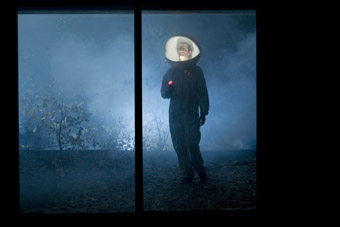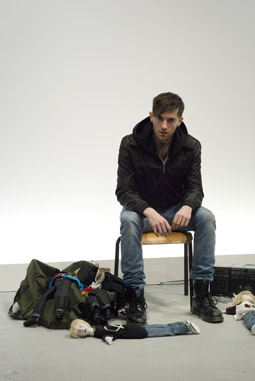keeping up with the audience
julieanne campbell: new york contemporary performance

Effet Serge
photo Argyroglo Callias Bey
Effet Serge
IN JANUARY, NEW YORK’S COLDEST MONTH, OVER 2,000 DELEGATES FROM THE ASSOCIATION OF PERFORMING ARTS PRESENTERS (APAP) DESCENDED ON THE CITY FOR THEIR ANNUAL CONFERENCE. APAP IS THE EQUIVALENT OF THE AUSTRALIAN PERFORMING ARTS MARKET (APAM) ONLY, LIKE ALL THINGS AMERICAN, BIGGER. IN AN EFFORT TO EXCITE ARTS PRESENTERS FROM ACROSS THE COUNTRY, PS122, THE PUBLIC THEATRE AND ASSOCIATED ARTS CENTRES TROTTED OUT THEIR BEST AND BRIGHTEST.
For the past five years, Performance Space 122 (PS122) has presented COIL during APAP, an annual winter festival of contemporary performance. It’s an alternative to the compromised format of showcases and, in 2010, COIL was pitched as “14 companies in 12 days.” The works were full-length and open to New York’s holiday-fatigued public to enjoy treats of a different kind. Following PS122’s lead, the Public Theatre presented its sixth annual Under the Radar festival, also during APAP, equally ambitious but with stronger emphasis on theatre and international artists. Despite the sub-zero temperatures, audiences brave the cold and this previous dead period for the performing arts in New York now buzzes.
“Audiences and artists alike have a constant thirst for new stuff,” explained PS122’s Artistic Director Vallejo Gantner. “It’s typical of New Yorkers’ addiction to be the one to ‘discover’ someone or something.” I had coffee with Gantner at his local café where he talked about COIL and more broadly the contemporary performance scene in New York. “In terms of hybrid work, [local artists] have moved through the period of collaborations—the investigative styles of Richard Foreman and the Wooster Group. It seems there’s a renewed interest in ‘screwing around’.” The aesthetic is messy, and Gantner explained that current work directly engages with everyday experience—not dissimilar to work in Australia. “We live a hybrid existence. If anything, audiences have outpaced the work being made.” Gantner cited companies such as Radiohole, Temporary Distortion (who presented Americana Kamikaze at COIL; see RT95) and artist Reid Farrington. “These artists delve into the experiential consequence of technology, demonstrating how we deal with information and data.”
richard maxwell, ads
A good example is Ads, a co-presentation between New York City Players, PS122 and the Public Theatre. Conceived and directed by Richard Maxwell, hyper-real, life-size images of ‘everyday people’ are projected onto an otherwise empty stage. One-by-one, they ‘step’ onto a small, raised platform and orate their beliefs. The high-definition projection, supported by sound that captures the shuffle of footsteps and rustle of clothing as speakers step onto their ‘soapbox’, is so convincing that days later, my friend who saw the show exclaimed over coffee, “They really weren’t there?”
The work began with a woman in her 60s, commenting that adults use Blackberrys like pacifiers. Teenagers have heads bowed, not in prayer, but texting in monosyllables. We’re desperate to stay connected via social networking tools such as Facebook, she lamented, but nothing beats the connection between family and friends over Sunday lunch. “The human connection is missing,” said the projected woman. Subsequent manifestos didn’t resonate with quite the same irony, but did provide an astonishing survey of people and their lives, from musicians to real estate agents, parenting at 50 to existential nihilism. “I believe this world has already ended,” says a man in his early 20s with a t-shirt that reads, “Brooklyn Go Hard”.

Jonathan Capdevielle, Jerk
photo Alain Monot
Jonathan Capdevielle, Jerk
jerk
At the other end of the spectrum is Jerk, from France, directed by Gisele Vienne, text by Dennis Cooper and performed by Jonathan Capdevielle. Here the only technology used is a boom box. The work relies on puppets to reveal a disturbing story based on serial killer Dean Corll’s murders of 20 teenage boys in the 1970s. Capdevielle portrays David Brooks, one of two teenage boys who assisted Corll in brutally sodomising his victims. Brooks, in prison serving a life sentence, addresses the audience as if to a group of psychology students at a local university, explaining he will use puppets to reconstruct the murders, and suggesting this may help him take responsibility for his actions.
At first, the puppets appear with masks: Corll in a panda mask and Wayne Henley, Brooks’s teenage accomplice, in a white, fluffy dog-like mask. Given comic voices—one very high, one very low—the hand puppets perform like Punch and Judy, except with knives, creating for the audience a separation from the brutality of the actions, perhaps similar to the disconnection from reality experienced by the murderers. When the masks come off, the puppets are unsettlingly more human. Visceral and base, Capdevielle, at times dribbling, delivers an extraordinary performance that makes such sickness plausible, exploring the dark edge of sex and death. David Brooks’ text, which we are directed to read at certain points from a small booklet accompanied by photos and illustrations of the puppets and possibly the victims, adds another level of detail and depravity. The work was slammed by The New York Times, but it stayed with me like a sick and worrying dream [see also PuSh review of Jerk].
east 10th street
With all the boundary-pushing work on show, it was strangely comforting to see East 10th Street by Edgar Oliver. On a sparse stage with only one light, this seasoned performer took us back to the bohemian days of the East Village. Living as a young artist in a boarding house on East 10th Street with his sister, Oliver described in a slightly camp, Vincent Price-type voice, a bizarre collection of characters and events which seemed to emerge from the shadows around him: Donald Milburn who drank vodka with milk; Frances, the “Lady Macbeth of Rags” who spent more time in the share bathroom than in her room; Edwin Linder, with eight padlocks on his door; and Freddie the midget, who never left or entered the house through the front door, but instead used the old coal shute. Oliver weaves in a love affair with the “brilliant and wildly charismatic” Jason Boner that is never consummated, leaving me with an equal sense of longing. By the end I was nostalgic not just for this ghostly and colourful history of the East Village, but for simple, polished and crafted work delivered by a pro.
l’effet de serge
L’Effet de Serge, presented at 3LD Art and Technology Centre in New York’s financial district was not local fare, being an import from Paris-based Vivarium Studio. But it was a festival favourite of mine, and equally charmed New York audiences with its quirky, low-tech premise and staging. Underplayed to great humorous effect by company founder Philippe Quesne, it began with a spaceman in an oversized helmet, lit from within. He explained that this was a show about Serge, and this was Serge’s apartment, but that each show begins with the end of the last show, which had a spaceman in it, hence the outfit. Serge likes to make things, and does small performances for audiences of one or two.
Quesne’s long and languid body heightened each action, whether unpacking groceries, ordering pizza, testing a new novelty toy or awkwardly taking guests’ coats and offering them wine. Delivered with care and attention, the actions were beyond pedestrian, delightfully deadpan yet seductive in making us invest as much in Serge’s mini performances of light and sound as he did.
Despite the Global Financial Crisis, which is far more palpable in the USA than in Australia, audience numbers seem unaffected, and for PS122, Gantner confirmed that box office has never been better. “The majority of New Yorkers live in 400 square metre apartments so they have to get out. It’s not a case of, ‘Do I have the disposable income or not?’ It’s why you’re here.”
APAP Conference, Jan 8-12, www.APAPconference.org; COIL, Performance Space 122, Jan 6-17, www.ps122.org; The Public Theater, Under the Radar, Jan 6-17, www.publictheater.org; New York
RealTime issue #96 April-May 2010 pg. 32






